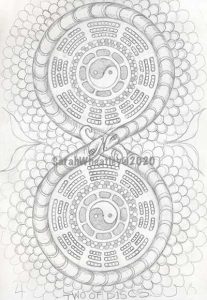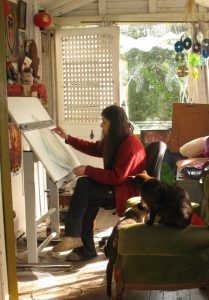In September 2005 I started painting Tarot cards to amuse myself. My first card was the Hanged Man, which was inspired by the sad tale of a brilliant musician called Koh Morota who drowned himself in a river. More cards followed and the project quickly snowballed into an epic of creation that lasted thirteen years. I worked on it full time for all that time, but it never felt like work, even though it was often exhausting. I was excited to start in the mornings, lost in the flow all day, and reluctant to finish at night. It was a wonderful adventure right from the start and I wish I could do it all again. Creating my deck was an all consuming obsession, and a passion I happily sacrificed a great deal to achieve. I turned forty in 2006 and this crisis of mid life no doubt was part of my inspiration to do something really epic while I still had the energy and opportunity. I made several life style changes for the sake of my health and these transformations helped me to find the clarity and determination to really do some intense work. One thing fed into another, and the work itself healed me and transformed my life further. It was an amazingly therapeutic feedback loop. The process of making a Tarot suited my talents perfectly because I love reading and writing as well as painting, and I have always had an interest in occult matters, so the research was just as enjoyable as the artwork. I started reading the Tarot in my early twenties when I was given a copy of the Thoth deck, and I have always greatly admired the artwork of Frieda Harris.

Over time I developed a system of creation, a cycle of production timed with the phases of the moon. I would brain storm, research and make sketches from the new moon onwards and usually come up with a drawn design by the full moon. Then I would paint the card and do all the detail work in the waning moon. There was a lot of sketching, and a lot of dreaming. I have recently included a gallery of sketches on my Tarot Gallery page. Ideas come to when you plant the seeds. Often I would go to sleep thinking about the ideas and wake up with a solution. It always felt like I was receiving the material rather than conceiving it. I would play around with shapes and symbols and then suddenly a design would pop out that I knew would be a great painting. I also found that life would reflect the art, and synchronistically generate ideas with appropriate events and emotional crises. Certain cards had very powerful effects on my psychic energy and even my physical health. These effects were sometimes temporarily distressing but in the end always beneficial and empowering. I had always used art as a psychoanalytic tool, and the Tarot seemed to magnify this application immensely. It was a truly fascinating experience and I came to realise that the cards regarded as the most difficult psychologically were actually the most rewarding.

Once I had my design I would cut a 50 by 35cm piece of rag paper (300 gsm Arches medium rough), stick it to my drafting board and draw it up, with all the lettering and symbols included. It seemed very important to me to do the lettering by hand as a part of the painting rather than in post production. In retrospect I would have made my life much easier if I had kept the text separate, but it did make the deck design unique. I mostly used acrylic inks for the base colours. They are great for doing waterproof transparent areas, which you can then easily overpaint with watercolour or gouache for detail. The texture of the rag paper really shines through and its still possible to see the drawn design underneath. If you want to make beautiful pictures you need good quality materials. Some cards came quickly and easily. The Minors were a joy to create and took only a year to produce. I developed a system of geometric and numerological designs that really took off. There was a lot of compass work, and a lot of sacred geometry, and absolutely no digital work needed on any of them. What a gift! Unfortunately producing such a surprisingly satisfying run of Minors made me dissatisfied with the full set of Majors I had produced before that, and ended up inspiring me to paint them all again. I’d probably advise creators to start with the Minors, because then you are at the top of your game when you get to the more difficult cards. Another surprising thing about the Minors was how much I loved painting the cards I had always thought of as difficult, like the Nine of Swords and the Five of Discs. I really learned to appreciate that every card is a glorious paradox. I think perhaps if the Thoth deck has a flaw it is that its hard cards are a little too gloomy and one sided.
For many of the Majors and all the Courts, the main problem was coming up with a good figure pose. This was done with the assistance of my photographer partner. Almost all of the figures I posed for and he photographed, and some the other way around. I then drew from the photographs, adapting and morphing the figures in various ways. In some cases I even changed the sex. Getting a good pose meant finding a pleasing shape that reflected the meaning of the card and fitted nicely into the shape of the design. In some cases we took literally hundreds of photos before finding the right one. It was the first example of how essential digital technology would be for this deck. The Courts were particularly gruelling for me and a few of them I painted three or four times! The Majors also had at least two versions and in some cases three or four. Each one took ages to paint, in some cases months of work. I thought I’d wasted a lot of time on redundant versions (although I really enjoyed painting all of them and did not regret any of it). However when I reached the final stage of creation, digitising and manipulating images, I realised I could use all the versions and in fact every single painting would be invaluable as collage material. It was quite an exciting (if rather tiring) stage of development. At least a year was spent on shuffling bits of painting about on the computer. It would be quite a different deck without the digital collaging I did on many of the Majors and Courts. A much less satisfying one for me at any rate. My one rule was to only use hand painted elements. Some of the cards ended up with literally hundreds of fragments and dozens of layers, with files of more than a gigabyte. There are many versions of each card, leading up to the final version. Some of the most complex collages are the Magus, the Empress, the Priestess, and the Emperor, though there are plenty of others as well. Some of the Majors are completely without digital alteration, such as Death and the Devil. Generally speaking, the mandalas in the deck are pretty much as painted. I loved painting the mandalas and it’s something I’ve continued to do after finishing the deck.
I have never painted anything digitally and I probably never will. Painting to me is all about the translucence and tactile qualities of paper and paint. I’m not naturally a digital artist of any kind, but for this project it seemed to be necessary, and in the end I did really enjoy the collaging and its endless possibilities. I did all my own formatting for print as well, including a very laborious late addition of bleed areas. In fact, I have done absolutely everything myself, learning on the job, which is partly why it all took so long. I am far too much of a perfectionist control freak to do it any other way. For much the same reason I will go on publishing the deck independently. It’s the only Tarot deck I will probably ever create, though it may change a bit from time to time, and so I want to keep total control of every aspect of its emergence, just as I did its creation. I am currently considering my options as to the third edition. A lot depends on whether the Virus shuts Chinese production down again because that is certainly where it will be printed, one way or another. We are in very uncertain times, but all this isolation is a good opportunity for some meditation and self reflection. It’s a good time to be a Hermit like me.
Take care and look after each other,
Love Sarah